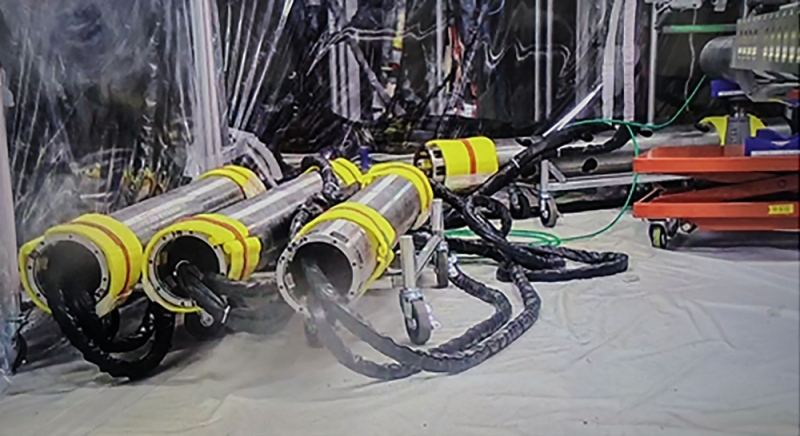
This handout photo taken on August 22, 2024 shows pipes for the installation of a telescopic device to be used for the removal of radioactive debris in Fukushima reactor. — AFP pic
Friday, 23 Aug 2024
TOKYO, Aug 23 — The operator of Japan’s stricken Fukushima nuclear power plant said this week’s trial removal of radioactive debris from a battered reactor has been postponed due to a technical issue.
Tokyo Electric Power Company (Tepco) was aiming to remove a tiny sample of the estimated 880 tons of radioactive debris believed to sit inside reactors at the tsunami-hit nuclear plant.
But after carrying out the preliminary steps of the trial retrieval yesterday morning, a Tepco spokesperson said the operator had “decided to suspend the work”.
The trial removal will not resume on today as the operator has to “investigate the cause of the trouble,” another spokesman Tatsuya Matoba told AFP today.
“We can’t exclude the possibility that we resume this Saturday, but personally I’ve never experienced this kind of operation starting on Saturday or Sunday,” he said.
He added that it was also unclear whether the work would resume next week.
“It depends on how deeply we’ll investigate,” he said.
Three of Fukushima Daiichi nuclear plant’s six reactors were operating when a tsunami hit on March 11, 2011, knocking down cooling systems and sending them into meltdown in what became the worst nuclear disaster since Chernobyl.
In three units of the Fukushima plant, fuel and other material melted and then solidified into highly radioactive “fuel debris”.
The tiny sample was to be studied for clues about the condition of the inside of the reactors and their hazardous contents, a crucial step towards decommissioning the plant.
The debris has radiation levels so high that Tepco has had to develop specialised robots that can withstand them to function inside.
Removing it has long been dubbed the most daunting challenge in the decades-long project to decommission the Fukushima Daiichi nuclear plant.
Tepco deployed two mini-drones and a “snake-shaped robot” into one of the three nuclear reactors in February, as part of the preparations for the removal task.
The latest probe, equipped with a robotic arm, is expected to take about a week to reach radioactive debris inside the reactor and should emerge again with the sample next month.
Japan began almost a year ago to release wastewater from the stricken plant into the Pacific Ocean.
The step has sparked a diplomatic row with China and Russia.
Both countries have banned Japanese seafood imports, although Tokyo insists the discharge is safe, a view backed by the UN atomic agency. — AFP
TOKYO, Aug 23 — The operator of Japan’s stricken Fukushima nuclear power plant said this week’s trial removal of radioactive debris from a battered reactor has been postponed due to a technical issue.
Tokyo Electric Power Company (Tepco) was aiming to remove a tiny sample of the estimated 880 tons of radioactive debris believed to sit inside reactors at the tsunami-hit nuclear plant.
But after carrying out the preliminary steps of the trial retrieval yesterday morning, a Tepco spokesperson said the operator had “decided to suspend the work”.
The trial removal will not resume on today as the operator has to “investigate the cause of the trouble,” another spokesman Tatsuya Matoba told AFP today.
“We can’t exclude the possibility that we resume this Saturday, but personally I’ve never experienced this kind of operation starting on Saturday or Sunday,” he said.
He added that it was also unclear whether the work would resume next week.
“It depends on how deeply we’ll investigate,” he said.
Three of Fukushima Daiichi nuclear plant’s six reactors were operating when a tsunami hit on March 11, 2011, knocking down cooling systems and sending them into meltdown in what became the worst nuclear disaster since Chernobyl.
In three units of the Fukushima plant, fuel and other material melted and then solidified into highly radioactive “fuel debris”.
The tiny sample was to be studied for clues about the condition of the inside of the reactors and their hazardous contents, a crucial step towards decommissioning the plant.
The debris has radiation levels so high that Tepco has had to develop specialised robots that can withstand them to function inside.
Removing it has long been dubbed the most daunting challenge in the decades-long project to decommission the Fukushima Daiichi nuclear plant.
Tepco deployed two mini-drones and a “snake-shaped robot” into one of the three nuclear reactors in February, as part of the preparations for the removal task.
The latest probe, equipped with a robotic arm, is expected to take about a week to reach radioactive debris inside the reactor and should emerge again with the sample next month.
Japan began almost a year ago to release wastewater from the stricken plant into the Pacific Ocean.
The step has sparked a diplomatic row with China and Russia.
Both countries have banned Japanese seafood imports, although Tokyo insists the discharge is safe, a view backed by the UN atomic agency. — AFP
No comments:
Post a Comment